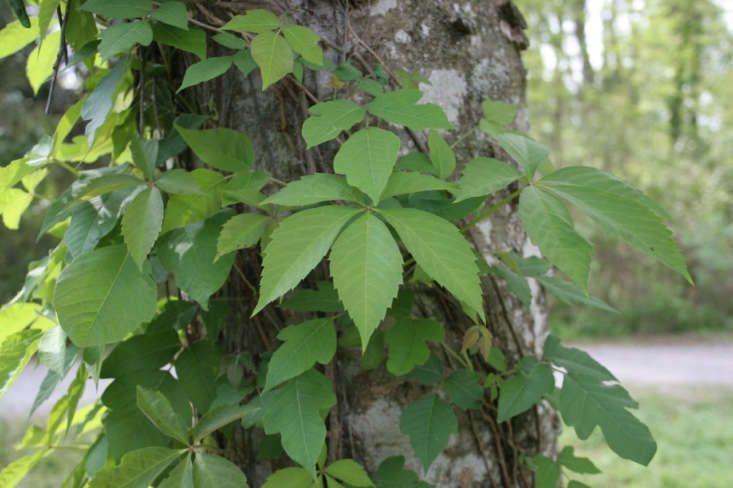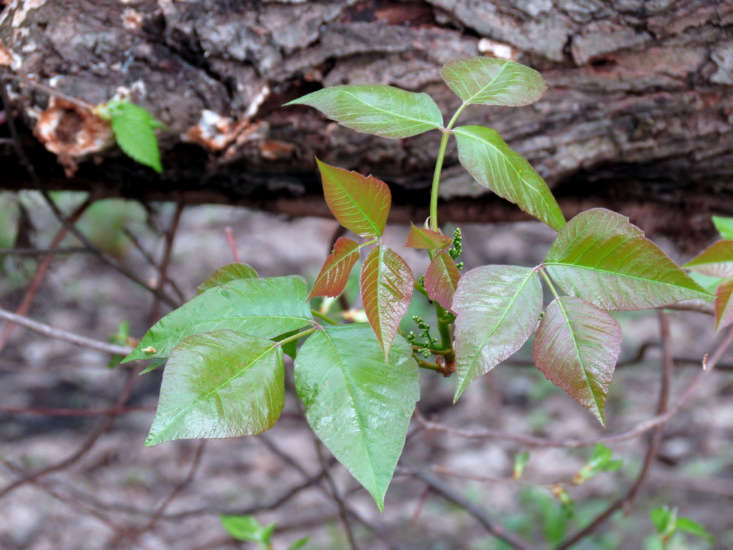The other day, my neighbor with an enviable flower garden in the front and a vegetable one in the back, snuck up on me while I was weeding, looked over my shoulder, and promptly announced, “That’s poison ivy.”
“Are you sure?” I asked, skeptical. She had, after all, told me the same thing the prior spring, but what she had deemed poison ivy then turned out to be a strawberry patch.
“Yes,” she replied, emphatically. I looked closer. No cute budding berries this time. I rushed inside to wash my hands; then I sat down to do some research, starting with Michelle’s great post on how to get rid of it.
Here’s what I learned about summer’s longtime villain:

1. Poison ivy is hard to identify.
You’ve likely heard of the saying “leaves of three, let it be,” and that’s certainly helpful when it comes to spotting poison ivy: The plant, indeed, is characterized by a triumvirate of leaves that start out red in the spring, turn green in the summer, and then yellow, orange, or red in the fall. Trouble is, it’s not the only plant that’s three-leafed. Boxelder, young Virginia creepers, and, yes, strawberries, all have three leaves per stem and are often mistaken for poison ivy.
To complicate matters, there are dozens of poison ivy species. Some have tiny leaves, others large. Some grow as ground cover, others as low shrubs, and still others as climbing vines. Leaves can be toothed or smooth. And they may or may not have a glossy appearance.
2. Some even grow flowers and berries!
In the summer, the weed may produce clusters of tiny yellow-green flowers, which later develop into whitish berries. Cute, right? Only if you’re a bird who likes to snack on these berries. In the winter, the berries may still be around but not the leaves, making it especially difficult to identify the plant.
3. A handful of states have no poison ivy.
Poison ivy is a menace in the vast majority of the U.S.—except, according to the CDC, Alaska, California, and Hawaii! (The East Coast-West Coast rivalry just tipped heavily in favor of West Coast.)

4. The rash isn’t contagious.
When my husband had a wicked rash on his legs after brushing up against poison ivy while trail running, I insisted he wear pajama pants to bed and basically steered clear of him whenever I glimpsed the angry red welts. Cold-hearted, I know, but after seeing his misery, I wanted to make sure the rash wouldn’t spread to me.
Thing is, the rash isn’t contagious. The rash occurs wherever skin touches urushiol, the oil on poison ivy that triggers the immune system to attack the skin. Even if the rash is severe and the blisters break, the fluid in the blisters isn’t contagious; there’s no urushiol in it.
If a rash spreads to a different part of the body, it’s often due to scratching with fingernails that have oil stuck under them.
5. Not everyone’s allergic to it.
Some people can rub their naked bodies all over poison ivy and have absolutely no reaction to it. In fact, about 15 percent of the population is immune to the effects of urushiol. (If you have such people in your life, enlist them immediately to help you weed out the poison ivy in your garden.)
6. If you’ve had a rash before, beware the next one.
Getting a rash from poison ivy doesn’t inoculate you against the next exposure. In fact, it means your next rash will likely be worse, because your immune system will have gotten better at recognizing urushiol.

7. There’s zero chance that your pet will be affected.
Only humans and a few primates are allergic to urushiol. Every other animal is blessedly immune. You still need to be careful with your pets, though, if they’ve been in contact with poison ivy; they may have gotten some of its oil on their fur, which, if it ends up touching your skin, can trigger a rash on you.
8. Poison ivy is related to mangoes!
This may end your romance with mangoes forever: Poison ivy belongs to the plant family, Anacardiaceae, which makes it a relative of mangoes. They both produce urushiol, which is why people who eat the fruit without taking off the skin first can sometimes get a blister rash on their lips.

9. There are natural ways to kill it.
You don’t need to resort to chemical herbicides like Roundup or Brush-B-Gone to get rid of poison ivy. In fact, the most effective method is to simply pull them out by the roots. (See Landscaping 101: How to Kill Poison Ivy.) To do that without risking exposure, Michelle recommends: “Put on long sleeves and pants, tape your pants and shirt cuffs to prevent skin exposure, pull on a pair of heavy gloves, and dig out as much poison ivy as you can. The trick is to get the roots, which means digging down a few inches—at least six—beneath roots and then reaching in to pull them out.”
One important no-no to be aware of: Never burn poison ivy. You may be tempted to do so to completely eradicate its existence, but the oil can go airborne in the smoke and land on your face, exposed skin, or, worse, in the lungs.
10. It can come back from the dead.
Urushiol lingers—for years sometimes—on almost all surfaces, so be sure to wash your gardening clothing and tools. And even when poison ivy is dead and there are no leaves left, there’s still urushiol on the stems and roots. It’s not uncommon for people to unknowingly come in contact with urushiol in the winter, say, by chopping wood that once had poison ivy growing on it.
For more gardening 101 stories, see:
- Garden Tools: Which Trowel Is Best for You?
- Your First Garden: 5 Reasons to Pull Up a Plant
- Your First Garden: 5 Rookie Mistakes to Avoid This Spring








Have a Question or Comment About This Post?
Join the conversation